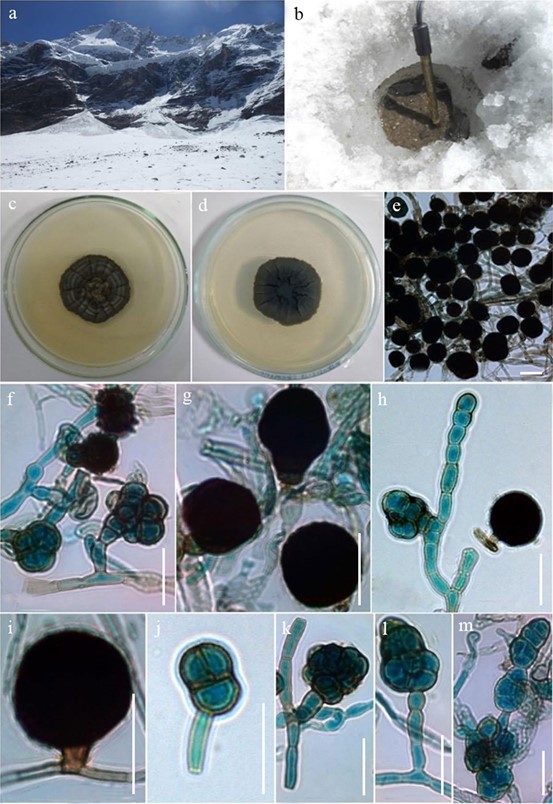Bhagirathimyces himalayensis S.M. Singh & S.K. Singh, sp. nov.
MycoBank number: MB 830752; Index Fungorum number: IF 830752; Facesoffungi number: FoF 06122; Fig. 62
Etymology: The specific epithet “himalayensis” refers to the Himalaya, the region of origin of the sample.
Holotype: AMH 10127
Isolated from Cryconite of glacier. Sexual morph Undetermined. Asexual morph Hyphomycetous. Vegetative hyphae smooth to rough walled, septate subhyaline to light olivaceous, constricted near septa, up to 6.2 μm wide. Conidiophores arising from superficial hyphae, small to median large, micronematous, mononematous, simple, rarely branched, straight, light olivaceous to olivaceous brown, smooth-walled, 1–3-septate, 5.9–44.1 × 4.2–19.4 μm. Conidiogenous cells monoblastic, integrated, terminal, determinate, cylindrical. Conidia solitary or catenate, very variable in shape and size, lobed, globose to subglobose, clavate, muriform, often with a pale protuberant basal stalk cell, persistent to sessile, smooth-walled, sometimes spinulose, dark brown to blackish brown, sometimes olivaceous brown, 15.4–50.4 × 12.8–46.2 μm (x̄ = 26.8 × 22.4 μm, n = 30).
Culture characteristics: On PDA greyish black (10F-1), reaching 2.2 cm diam. in 15 days at 25 °C, velvety, sulcate with successive growth rings, regular margin, reverse greyish black (10F-1).
Material examined: INDIA, Himachal Pradesh, Hamtah Glacier, Lahaul and Spiti District, from Cryconites, 16 September 2016, S.M. Singh, AMH 10127 (holotype), ex-type living culture, NFCCI 4580.
GenBank numbers: ITS =MK836021, LSU = MK836020, TEF1-α = MT091965.
Notes: Because of the presence of muriform conidia, Bhagirathimyces himalayensis is distinct from many allied genera. To some extent it resembles Trimmatostroma scutellare (Berk. & Br.) Ellis and Epicoccum andropogonis (Ces.) Schol-Schwarz (= Cerebella andropogonis Ces.), but it lacks sporodochial stromata. It differs from Tetraploa in having muriform conidia, while they are setiform in Tetraploa. Bhagirathimyces himalayensis shows no morphological resemblance to the asexual coelomycetous state of Muriphaerosphaeria. Unfortunately, B. himalayensis cannot be compared with the allied genus Dematiopleospora, due to lack of a sexual morph. Bhagirathimyces himalayensis is also similar to Paradictyoathrinium diffractum, but differs in having catenate muriform conidia with a cylindrical basal stalk. The colour of the conidia are jet black in the former taxon, while they are brown in latter taxon.

Fig. 62 Bhagirathimyces himalayensis (AMH 10127, holotype). a Landscape of the sampling location at Hamtah glacier. b Cryoconites with pH probe. c Colony morphology on PDA (front view). d Reverse view of colony. e Numerous conidia. f Lobbed conidia (muriform) attached with conidiophores. g Globose to subglobose and obclavate conidia. h Branched conidiophore with attached conidia. i Attached conidia and conidiophores. j Conidia with a pale basal stalk cell. k Branched conidiophore with muriform conidium. l Macronematous conidiophore with conidium. m Conidia in chain. Scale bars: e–m = 20 μm
